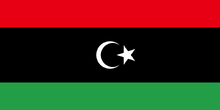
Libya (Arabic: ليبيا, Lībyā; Berber: Libya, ⵍⵉⴱⵢⴰ; Italian: Libia), is a country in the Maghreb region of North
Africa bordered by the Mediterranean Sea to the north, Egypt to the east, Sudan to the southeast, Chad and Niger to the south, and Algeria and Tunisia to the west. The three traditional parts of the country are Tripolitania, Fezzan and Cyrenaica. With an area of almost 1.8 million square kilometres (700,000 sq mi), Libya is the fourth largest country in Africa, and is the 17th largest country in the world.[6] Libya has the 10th-largest proven oil reserves of any country in the world.[7]
The largest city and capital, Tripoli, is located in western Libya and contains over one million[8] of Libya's six million people. The other large city is Benghazi, which is located in eastern Libya.
Libya has been inhabited by Berbers since the late Bronze Age. The Phoenicians established trading posts in western Libya, and Ancient Greek colonists established city-states in eastern Libya. Libya was variously ruled byPersians, Egyptians and Greek-Egyptians before becoming a part of the Roman Empire. Libya was an early center of Christianity. After the fall of the Western Roman Empire, the area of Libya was mostly occupied by theVandals until the 7th century, when invasions brought Islam and Arab colonization. In the sixteenth century, the Spanish Empire and the Knights of St John occupied Tripoli, until Ottoman rule began in 1551. Libya was involved in the Barbary Wars of the 18th and 19th centuries. Ottoman rule continued until the twentieth-century Italian occupation of Libya and large-scale Italian immigration. Italian rule ended during the Second World War, during which Libya was an important area of warfare. The Italian population then went into decline. Libya became an independent kingdom in 1951.
In 1969, a military coup overthrew King Idris I, beginning a period of improved living standards and brutal suppression of dissent. The most prominent coup conspirator, Muammar Gaddafi, was ultimately able to fully concentrate power in his own hands during the Libyan Cultural Revolution. Muammar Gaddafi remained in power until a civil war, in which the rebels were supported by NATO without US Congressional support.[9][10][11][12][13] Russia abstained.[14][15] Since then, Libya has experienced instability and political violence which has severely affected both commerce and oil production.[16] The European Union is involved in an "operation to disrupt human smuggling networks" fleeing the war for Europe.[17][18]
The Eastern government in Libya is the Council of Deputies. Other governments are the West Libya Dawn movement's new General National Congress, dominated by the Muslim Brotherhood, in Tripoli (which is where pro-Ghadaffi forces held out longest),[19] Ansar al-Sharia in Benghazi, and the Islamic State in Derna. The Guardian considers the possibility of a partition.[20] The NATO-endorsed government in the East has pulled out of UN peace talks.[21]
All sources from Wikipedia.
